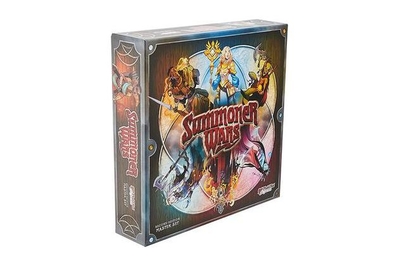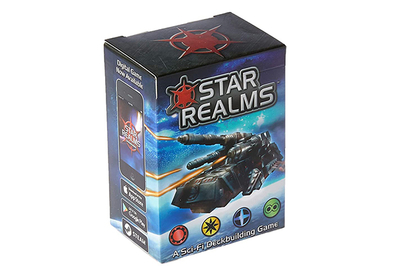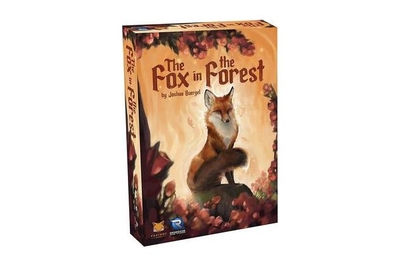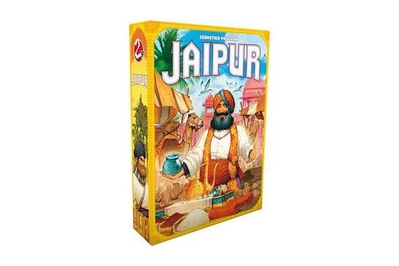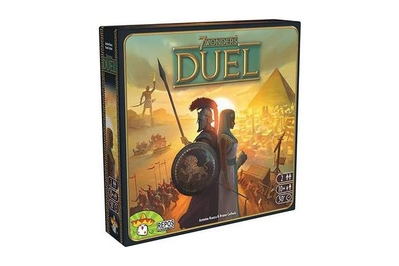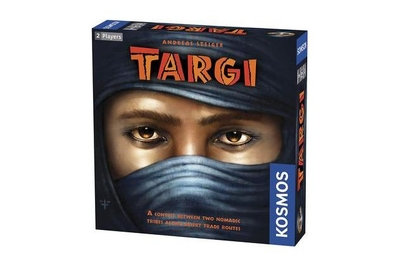
By James Austin
James Austin is a writer covering games and hobbies, which means he is in a constant cycle of learning board games and teaching them to people.
Many of the most popular tabletop board games are designed for big groups—that’s what game nights are about, after all. But coordinating the schedules of a bunch of adults can be a puzzle more intimidating than the Saturday New York Times Crossword, so it’s nice to have options for a quiet night in with a partner, roommate, or friend.
Two-player games have come a long way since checkers, backgammon, and Battleship, and today the best of them are just as complex and enthralling as any group game.
We talked with experts, spent more than 25 hours researching, and played 34 different games to find the one-on-one games that most people will enjoy.
Advertisement
SKIP ADVERTISEMENTDuel games
Ideal for a pair of players who want to test each other’s abilities, these games are much more reliant on skill than luck.
They have high skill ceilings, so they continue to provide challenges for even experienced players. But these games also tend to be easy to learn, which helps new players progress quickly, even if they’re outpaced in their first few games by a more skillful opponent.
A chess-like game that’s fun to play: Hive

Top pick
In this quick tile-laying game, you attempt to surround your opponent’s queen. It scratches the chess itch without actually requiring you to play chess.
How it’s played: Hive is a game of placing and moving bugs, represented by tiles, in order to surround your opponent’s queen bee.
On each turn, players either place a new piece from their collection onto the table or move one that they placed in a previous turn. Each piece—a beetle, ant, or grasshopper—has a unique way to move on the table, and when a piece moves, it must not leave any other pieces stranded from the group (“breaking the hive”).
Once a player’s queen is surrounded—whether by their opponent’s pieces, their own pieces, or a combination—that player loses.
Why it’s great: Hive has all the tactical depth of chess but none of that game’s cultural expectations. This is a deeply strategic game that is simple to learn and play—on any one turn you can take just one of two possible actions—but it’s still deep enough to keep revealing new strategies, even after you’ve played dozens of games.
It also takes no time to set up. There’s no board to assemble or deck of cards to shuffle—just tiles in a bag—so you can jump right into playing.
Flaws but not dealbreakers: More so than the other games in this guide, Hive is a test of each player’s skill, which can be challenging for a new player facing an experienced opponent. But it’s still a simple enough game to learn that new players can gain ground quickly.
Duration: 30 minutes
Rules: website
Digital version: Board Game Arena
A block-sliding puzzle, but with wizards: Summoner Wars

How it’s played: A battling card game that takes place on a 5-by-8 grid, Summoner Wars feels like a mix of Dungeons & Dragons combat and a particularly tricky Legend of Zelda temple block puzzle.
You select a fully assembled deck representing one of six factions, each of which has unique powers and encourages different play styles. For instance, the Vanguard faction prioritizes healing and boosting its units’ power, while the Fallen Kingdom can power up some of its units by sacrificing others.
Players get a small supply of magic that they can use to summon units onto the board; turns consist of these summonings, unit movement, and attacks. The ultimate goal, of course, is to eliminate the other player’s summoner.
Why it’s great: Though Summoner Wars is as tactically deep and interesting as more elaborate war games we tested, such as Undaunted or Memoir ’44, it requires much less time to set up and learn.
The game mechanics are extremely well balanced: The magic you use to summon units onto the field is regained only when you eliminate enemy units (which can be tricky) or discard cards from your hand (an extremely limited resource).
Each faction deck functions with an internal logic that doesn’t lock you into a specific play style but instead rewards you for learning the faction’s strengths and weaknesses.
Flaws but not dealbreakers: Despite feeling cramped in terms of card movement, the play grid occupies quite a large space on a table. Folks in smaller spaces, or those who like to have room for snacks and drinks on their play surface, may be annoyed by its sprawl.
In addition, the game doesn’t come with a deck organizer, so you need to supply a rubber band for each deck unless you want to spend time sorting them each time you play.
Duration: 40 to 60 minutes
Rules: PDF
Digital version: browser game
The platonic ideal of a deck-building card game: Star Realms

Top pick
A big game in a small package, this is a wonderful deck builder that plays quickly and invites replays.
How it’s played: Like the popular Dominion or Marvel’s Legendary, Star Realms is a deck-building game. Players “buy” cards from a shared market to power up their decks, deal damage, and eventually eliminate their opponent.
It grafts that basic system onto a wonderfully robust and interconnected world that rewards replays and accumulated game experience.
You start out with a very small deck of generic economic and martial ships, but you can quickly build a fleet of bases and ships from four different factions. When you play cards from the same faction together, they gain extra power. And because you and your opponent buy all of the available ships from a common market, you can keep track of what cards the other player picks up and try to foil their strategy.
Why it’s great: After a slow first couple of rounds, the game quickly ramps up. About 10 minutes in, you’ll suddenly find yourself buying space stations the size of planets and delivering haymakers as you and your opponent slug it out with your increasingly powerful decks. It’s especially competitive, too: Every game I’ve played has been a close match.
Flaws but not dealbreakers: The art can seem a little dated at times, reminiscent of early-aughts sci-fi trade-paperback covers. And even though the game mechanics are generally easy to learn, we found the health system to be unintuitive and clumsy.
Duration: 20 minutes
Rules: image
Digital version: Steam, Mac App Store, iOS App Store, Google Play
Relaxing games
Sometimes you don’t want to mercilessly grind your opponent into the dirt. Here are some options for lighter, more luck-based (but still interesting) games for a laid-back vibe.
A simple, quick, trick-taking game: The Fox in the Forest

Top pick
This game uses power cards and a unique scoring system to shake up a game-night staple.
How to play: Anyone who has played a trick-taking card game such as Spades or Hearts (or my family’s favorite, Oh Hell) will be familiar with the main mechanic in The Fox in the Forest.
Each player gets a hand of 13 cards from the 33-card deck, and the goal is to win tricks by playing the highest-value card. Higher value can be relative, though: Every odd-numbered card modifies the game slightly, giving you powers such as switching out the trump suit or forcing the other player to play a certain card.
There’s another catch, too. You don’t want to win too many tricks, since the scoring system works on a curve. To get the most points, you should aim to win either zero to three tricks or seven to nine tricks. Winning four to six tricks gets you fewer points, and if you win 10 tricks or more, you get no points at all for that hand. At the end of each round, the scores are added, and the first player to reach 21 points wins.
Why it’s great: The Fox in the Forest sits at the perfect intersection of luck and strategy for a quick, low-stakes game.
The trick-taking mechanic is familiar to most people and simple enough for newbies to learn quickly.
And the game’s unique features, such as the added power cards, keep the decisions interesting enough to differentiate it from playing-card classics.
Flaws but not dealbreakers: The box includes lots of little cardboard pieces for keeping score, but we found them more trouble than they were worth. Using a pen and paper was much easier.
Duration: 25 minutes
Rules: website
Digital version: Steam, iOS, Google Play
A quick and easy economic puzzle: Jaipur

Top pick
This quick game is the most accessible economic game we’ve tested, with a focus on trade and hand management.
How to play: Jaipur is a set-collection game in which players compete to be the best trader each round.
To start, players draw cards from a common row that contains both materials (diamonds, gold, silver, cloth, spice, leather) and camels (essentially a less-valuable commodity that you can use for strategic purposes).
Every turn, you can either draw one card from the common row, trade cards from the row for cards you hold, or sell materials for points. You can also choose to pick up all the camel cards in the market, but that gives your opponent a whole new row of cards to draw from, making it a calculated risk.
Once three types of goods are sold out—or the market runs out of cards—the round is over. The scores are added up, and whoever has the most points from the round gets a Seal of Excellence. The player who earns two seals first wins the game.
Why it’s great: Economic games have a reputation for being overly complicated or dull, but Jaipur sidesteps all of that by keeping the decisions simple and the tone light.
Luck is a factor in this game, but the balance never swings so far toward luck that you feel like your decisions don’t matter. It’s a constant challenge to pull valuable goods from the market without giving your opponent an opportunity to do the same.
Flaws but not dealbreakers: This game is elegant and well designed, but after you’ve played through it once or twice, you don’t have much more to learn or explore.
Duration: 25 minutes
Rules: PDF
Digital version: Board Game Arena, iOS App Store, Google Play
Advertisement
SKIP ADVERTISEMENTComplex challenges
The following games are more competitive than our relaxing picks, but they’re not quite as antagonistic as our duel-game picks.
They tend to offer multiple ways for players to win, and they usually involve competition over a shared resource supply, asymmetric powers for each player, or a mix of some or all of those features.
Build a civilization more wondrous than your opponent’s: 7 Wonders Duel

Top pick
In this complex, involved game, you keep track of multiple goals as you compete for a limited set of resources to develop the most impressive ancient city.
How it’s played: Your task in 7 Wonders Duel is to create a more magnificent civilization than your opponent—something you accomplish by building wonders like the Pyramids, the Hanging Gardens, and the Colossus.
Of all our picks, this is the one that feels the most like a modern multiplayer board game but pared down to work perfectly with two players.
You play the game over the course of three rounds. In each round, building cards are arranged into a pattern in the middle of the play surface, some face up and others face down. Players select building cards and either build them in their city, discard them to earn coins, or use them to construct a wonder.
Each building or wonder in your city not only earns you points or gold but also provides resources that make it easier for you to build more and more complex buildings, which earns you even more points and gold.
But having the most points at the end of the third round is just one way to win. You can also beat your opponent with military might, or you can win a science victory.
Why it’s great: This game feels a lot bigger than the other games on our list. You have many things to keep track of, on both your own and your opponent’s side of the board, as well as multiple ways to win.
Crucially, that abundance of options never feels overwhelming because of the game’s deliberate pacing. The wonders give you a target and a game plan for the first two rounds, but once you’ve accomplished those goals, the third and final round becomes a mad dash to the finish as you use the economic engines you’ve built to snatch as many victory points as possible.
Flaws but not dealbreakers: This game is probably the most intimidating of our picks—at least for tabletop gaming novices—due to its various win conditions and the amount of things to monitor and manage.
If you’re new to this kind of game, try to power through the challenging learning curve, and you’ll be rewarded with a complex, replayable experience.
Duration: 30 minutes
Rules: PDF
Digital version: Board Game Arena, iOS App Store, Google Play
Place workers and pull resources from the shifting sands: Targi

Top pick
This deceptively complex game asks you to do just one thing: place workers. But trying to figure out the best way to do that is surprisingly complicated—and fun.
How to play: Targi is hard to describe but surprisingly easy to learn.
The field of play is a grid of 25 cards. The 16 border cards are always placed in the same order and cannot be picked up by players. The nine inner cards consist of tribe and goods cards, which you can collect by placing workers on the border cards.
Both the border cards and the tribe and goods cards provide actions that players can take after placing their markers. The game ends when a player collects 12 tribe cards.
But since each tribe card has a different point value, the first player to 12 isn’t always the winner. These card bonuses allow for several different layers of strategy, and players must also contend with a robber that raids their supply of goods and gold at regular intervals.
Why it’s great: With just a few restrictions on how you can place your pawns, a game of Targi seems simple at first glance. But beneath the surface, you’ll find a wealth of complex decisions to make.
Trying to acquire the tribe cards you want can be maddeningly tricky, and since you can place workers only on unoccupied rows and columns, the placement options narrow quickly.
Those limitations would be a bummer in a more complicated game, but thanks to Targi’s rapid-fire pacing, you’re always thinking ahead.
Flaws but not dealbreakers: A few times during our testing, the game seemed to drag at the end—often because it became obvious who was going to win, and the last few turns merely became victory laps for the winner.
Duration: 40 minutes
Rules: PDF
Digital version: Board Game Arena
Cooperative two-player games
A dice-rolling, high-flying communication game: Sky Team

Top pick
This tricky cooperative game hinges on being able to understand your partner’s intent when you aren’t allowed to communicate.
Buying Options
How to play: In Sky Team, two players work together in the roles of pilot and copilot. Their goal: to deploy landing gear, keep their plane level, deploy aerodynamic flaps, and coordinate with air-traffic control in order to safely land the plane they’re flying.
To do this, they roll four dice per round and use the results to power particular actions, by moving those dice to specific places on the board. For example, each of the plane’s flaps requires one of two numbers to deploy, so if you want to deploy the first flap, you need a one or a two, for the second flap you need a two or a three, and so on.
Each player has distinct responsibilities; the pilot has to deploy the landing gear, for instance, while the copilot handles the flaps. But critical actions such as reducing the engine speed and keeping the plane level require both players to coordinate their die placement.
The tricky part is that all of this coordination has to happen silently. Players are forbidden to communicate once they’ve rolled their dice, and the value of their dice is hidden from their partner. You can’t use gestures, either—you have to intuit what your partner means to do.
If the plane makes it to the runway with the flaps and landing gear deployed, the brakes activated, the plane level, and the traffic in front cleared, both players win! If not, well, we can’t all be Sully Sullenberger.
Why it’s great: Figuring out how to communicate without words (or even charades) is kind of magical. Games that take advantage of that magic let you feel in sync with your friends in a way that other games just don’t. As a result, both wins and losses feel monumental, like a last-minute buzzer-beater.
Sky Team is one of the best at scratching that particular itch. And the game’s short rounds—four actions per player, which go by in about five minutes—help ease the communication burden, as each player tries to explain their actions, plan for the next round, and figure out their flight plan.
Flaws but not dealbreakers: This game is tough to teach because of its ban on direct communication. New players, when they don’t have a firm grasp of the mechanics, might not be able to intuit what their partner’s actions mean and make choices based on them, which is where the game really shines. But it’s straightforward enough that most players will make it past that bit of turbulence after a game or two, each of which usually takes only 30 minutes at most.
Duration: 15 to 30 minutes
Rules: PDF
Digital version: Board Game Arena
Advertisement
SKIP ADVERTISEMENTOther good two-player board games
If you’re in the mood for an action-packed, neon-infused card game: Radlands is a post-apocalyptic deck battler full of Mad Max–style characters dressed up in a Miami Vice color scheme, and it’s a quick and exciting game to play. The limited ways you can generate water (the essential resource that allows you to play cards or carry out their actions) keeps the action tense as you try to pick apart your opponent’s defenses without overextending yourself. This game is not as easy to pick up as Star Realms and not as strategically interesting as Summoner Wars, so those are probably better options for most people. But if you like those games and are looking for a new take on that style, Radlands is a good option.
If you’d prefer your war game to take place in Normandy instead of Narnia: Undaunted may be for you. A mix between deck-building games and straightforward war games, Undaunted is fun, easy to set up, and well balanced. It’s similar to Summoner Wars (which we liked slightly better in our play tests), so if you like the World War II theme better than swords and sorcery, you’ll have a great time with this game.
If the idea of “Battle Yahtzee” sounds appealing: Check out the dice-rolling superheroes of Marvel Dice Throne. In this game, each player selects a character from the Marvel Comics pantheon and gets a slate of powers and a set of six-sided dice. The players take turns rolling (and rerolling) dice much as in Yahtzee, but instead of checking off sets, they deal damage and use abilities to otherwise stymie their opponent. It’s a satisfying, easy-to-teach duel, and the designers have used the Marvel characters well. Each superbeing’s powers and abilities are true to their portrayal in the comics, which makes it easier for fans to pick up some of the gameplay mechanics.
If you want a more focused and intense version of one of our favorite beginner games: Splendor Duel takes all of the fun of the original (which already works well with two players) and adds a new layer of complexity and focus that’s tuned just for head-to-head play. Specifically, the Duel version adds new powers, tosses in a new precious material (pearls), and tweaks a few of the original’s core mechanics to juice up the gameplay, but it’s still focused on the same rewarding core.
If you want a two-player war game that only takes 20 minutes: Caesar is an area-control game that casts players as Caesar and Pompey in a battle to control the Roman republic. Its simple rules and cramped game board make it an easy game to learn and play, but its depth of strategy will keep players engaged even after dozens of playthroughs. That, combined with a run time of less than 20 minutes, means that this game often provides multiple rounds every time it’s brought out.
The competition
Air, Land, & Sea is a quick, card-based battle game in which players try to gain control over the three titular theaters of combat. Gameplay is a bit like that of the card game War, with players strategically deploying cards in their hand to win battles. These battles continue until one player reaches 12 points and wins. It’s a fast and easy little game, but in our testing it wasn’t as interesting as Star Realms or as relaxing as The Fox in the Forest.
Blitzkrieg and Dogfight are two games produced by the publisher of Caesar, and they fill a similar niche: sub-30-minute wargames that are easy to learn and play. They each tackle slightly different themes—Blitzkrieg focuses more on the tug-of-war battle in the theaters of World War II, while Dogfight is themed around World War I biplane combat. Ultimately, though, they all have a similar action structure and feel. All are fun to play, but we think Caesar is the best of the bunch.
Boop is a game about cats pushing each other off a bed. It’s similar to tic-tac-toe, which makes it very simple to teach, but the added wrinkle here is that every piece you place pushes every other piece (including your own) one space directly away from you. It’s fun, cute, and great for younger players, but we found it a bit simple in comparison with our picks.
Catapult Feud is a dexterity game that does what it says on the tin: Each player controls toy catapults and uses them to knock over fortresses that the other player has assembled. In our research, we found the gameplay to be a bit too simplistic for most adults, but this could be a fun game for younger players.
Claim is a trick-taking card game with a multi-round twist where players use their cards to gather supporters to their side in a quest to take a murdered king’s throne. This one is well reviewed, and it looked like a good game in our research, but on BoardGameGeek it didn’t rate as highly as the card games we opted to play-test instead.
Codenames Duet is a two-player version of one of our favorite party games, and unlike our picks here, it focuses on cooperation. Players alternate giving one-word clues to their partner to get them to correctly guess which word in a grid is an “agent”—without accidentally selecting the hidden “assassin” card that ends the game. It works well enough, but it mostly just reminded me of how much I like the original game.
Crokinole, a dexterity game invented in the mid-1800s, features a wide, circular wooden board and small discs, and its gameplay is like a mix of shuffleboard and curling. Players alternate flicking discs, attempting to land their own in a center ring while bashing their opponent’s out. It’s widely popular, but the smallest playing boards are around 27 inches in diameter and cost more than $60. That’s a big investment of both money and space for just two players.
Cryptid: Urban Legends casts one player as a mysterious cryptid trying to escape a city and puts the other in the role of a scientist trying to track down and capture them. Players use cards to move three colors of cubes between the squares of the ever-shifting board. The cryptid player’s goal is to create a recognizable pattern, while the scientist wants the opposite. The game’s concept and play style are unique, but the experience never really clicked for me or anyone I played with. It’s difficult to manipulate the cubes without alerting your opponent to your plan, which they can easily squash, leading to a stalemate—which makes the very short play time feel like a slog.
Fog of Love is a role-playing experience designed to be the board game equivalent of a romantic comedy. Using hidden objectives and situation cards that make each playthrough follow a familiar act structure, the game seems to build a good framework for role-playing choices. But Inhuman Conditions is slightly less intimidating in terms of time commitment, and its role-playing can be less emotionally fraught, so we think it’s a better game of this type to try first.
Just like 7 Wonders Duel, Imhotep: The Duel is a scaled-down version of a popular multiplayer game. But while it’s enjoyable enough, Imhotep’s gameplay doesn’t condense as effectively as that of 7 Wonders. In my testing the two-player experience felt smaller and less substantial, and the few options you have on your turn don’t feel as impactful, which made strategy choices straightforward to the point of being dull.
Inhuman Conditions is a former pick. We still love its theme and how good it is at introducing new players to role-playing, but it has been in and out of stock since we named it as a pick. As a result, we’re removing it from our list of recommendations for now. We’ll update this guide if and when it becomes more widely available.
Klask resembles a tabletop air-hockey table built by a particularly entrepreneurial woodshop teacher. It’s a dexterity game that combines magnets and reflexes, with your aim being to get a little plastic ball from your side of the board into your opponent’s goal. You do this by moving a pawn-like striker that is magnetically attached to a handle beneath the board. Little plastic magnets in the center of the board can attach to your striker and gum up the works. Klask is an exciting game to play and watch, and when I brought it to a game night with three of my friends, we had a good time setting up a quick little tournament. But it’s also quite large and fairly expensive for the amount of play time that most people are likely to get out of it.
Lost Cities is a card game where you push your luck by funding risky expeditions into various harsh environments. It’s an engaging concept, and games are quick, but we found several of the other card games we tested more fun to play—and almost all of them were easier to travel with than this game and its comically oversized box.
Memoir ’44 is one of the most accessible war games in production. It pairs the childlike fun of playing with little green army men with the feeling of a more involved battle game like the Standard Combat Series. Set in the European theater of World War II, this game is a great introduction to more tactics-heavy games like Undaunted. But it takes a long time to set up (it has a lot of little green army men), and it isn’t well balanced. And its frustrating movement system too often leaves you unable to control distant troops.
Odin’s Ravens is a card-based race between Huginn and Muninn, two ravens that serve the Norse god Odin. It’s quick and easy to get into, but the gameplay is shallow. The other card games on our list simply have more replay value.
Onitama is a quick and easy-to-learn chess-like game with just four pawns and a king. The main difference from chess is that instead of each piece having its own unique move, they’re controlled by cards. As you use these cards, they pass to your opponent, so the two of you are in a constant push-pull as you trade moves looking to get the upper hand. It’s a quick game—my playthroughs lasted about 15 minutes—but we enjoyed the depth of Hive more.
Patchwork is one of our beginner board game picks because of its simple and speedy play. The quilting-themed puzzler is easy to learn, and it has a 20-minute play time, so you can zip through multiple games of Tetris-like placing and arranging. But our picks here are better options for intermediate players.
Quoridor (pronounced like “corridor”) is a quick abstract puzzle in which players place walls and move a pawn between them. Each player has a supply of 10 walls and the goal of moving their pawn to the far side of the board first. On each turn, you can either move your pawn or place a wall to block your opponent. The game goes from friendly to cutthroat very quickly, and the simple concept makes it easy to teach and fun to play, but in our tests the shine wore off after only a few plays.
Rivals for Catan is a two-player card game set in the world of the wildly popular Catan. It seemed promising in our initial research, but it got lower scores on BoardGameGeek than the other card games we looked at, so we decided to exclude it from our testing.
Royal Visit is a tug-of-war in which each player uses cards in an attempt to convince a monarch to visit their duchy instead of the other player’s. But it didn’t rate as high as several other card games we saw in our research, so we opted not to play-test it.
Schotten Totten is a bit like an expanded Air, Land, & Sea in which you play cards from your hand with the goal of playing a higher-value set of three cards than your opponent, to win control of nine different control points (stones, in the game’s theming). It’s snappy, and the added tactic cards allow for plenty of strategic replayability, but we liked all of our duel picks a little more.
Star Wars: The Deckbuilding Game offers a lot of interesting twists on the classic deck-building format. It plays a bit like Star Realms, but in this case each player picks a side (dark or light) and is allowed to purchase cards only from the market that’s associated with their side. In addition to using cards to attack your opponent directly, you can spend damage to eliminate opposing cards from the market, which leads to some fun strategic play. This game is a great pick for a die-hard Star Wars fan, but everyone else is likely to have a better time with Star Realms.
That Time You Killed Me is an abstract game about two time travelers attempting to eliminate one another. They do so by jumping through three time periods (past, present, and future), which are represented by three small game boards. Each player’s goal is to trap their opponent’s pieces from various timelines. It’s an interesting concept, with actions on one board affecting the others in fun ways, and it includes a campaign mode of sorts that reveals more complex mechanics as the game progresses. However, it never really clicked with our testers as our picks did.
Till the Last Gasp is a two-player role-playing exercise that adds a few thoughtful design touches to help ease people into the role-playing experience. Through the course of the roughly 90-minute game, players spend dice to accomplish individual objectives that they’re given at the start. The game encourages dramatic storytelling but stops short of requiring it, focusing instead on manipulating the game area and one’s opponent with the dice. It’s plenty of fun with the right opponent, but Inhuman Conditions is a better intro to the genre.
Twilight Struggle is a fantastic game—one I really enjoyed learning during my initial testing for this guide—but its appeal faded quickly. Though I’ve revisited every other pick in this guide, I’ve never found myself coming back to this one. Long-term testing feedback from other Wirecutter staffers indicated that I’m not alone. It’s still a great game, but we’ve concluded that most people will get more play time and fun out of our other picks.
Undaunted: Battle of Britain takes the deck-building wargame mechanics of Undaunted: Normandy and focuses the action on the skies as the Luftwaffe and Royal Air Force dogfight over the British Isles. It follows the same basic structure of the other Undaunted games but adds new mechanics for aerial combat, all of which are well thought-out and evocative. We believe that most people will prefer to start with the first game of the series, but if you’re a dogfighting geek, this is a great game to get.
Watergate is a densely themed game that’s rich with historical research. Players assume the roles of President Richard Nixon and Washington Post reporters and engage in a tense tug-of-war in which the reporters try to expose the president’s wrongdoings before he accumulates enough political momentum to avoid consequences. It’s a great game for the right pair of players, and it can be fun to play over and over to create various alternate histories, but we wouldn’t recommend it for most people. Games don’t always have to be escapism, but during our playtesting in 2023 and 2024, we preferred games that weren’t so … relevant.
Advertisement
SKIP ADVERTISEMENTHow we picked and tested

To get an idea of what makes two-player board games successful, I reviewed lists and articles from board-game review sites such as Shut Up & Sit Down and Dicebreaker. I surveyed my Wirecutter colleagues for some of their favorite options. And I researched the most popular games on both Amazon and the BoardGameGeek forum.
To get experts’ perspectives, I also talked to Greg May, owner and operator of multiple New York City game cafés; award-winning game designer Jeeyon Shim; and Michele King, a communications professor and the director of William & Mary’s academic and applied esports program.
A lot of the features that make any game fun—being strategically balanced, having consistent play times, fostering satisfying interaction—are what we looked for when drawing up our list of two-player games to test. But outstanding two-player games have a couple of specific traits that are important to keep in mind:
- They should be easy to learn.
- They should be explicitly made for just two players.
And though you can find plenty of games that play well with two to four players (Quacks of Quedlinburg, Small World, and Wingspan are all good examples), games that are intentionally designed for just two people usually provide the most complete two-player experience.
During testing, I played each game we considered with a rotating crew of eight friends and volunteers, and I used their feedback to augment my own experiences. After playing each game at least once (though we played most multiple times), we arrived at our picks.
This article was edited by Ben Keough and Erica Ogg.
Meet your guide
James Austin is a staff writer currently covering games and hobbies, but he’s also worked on just about everything Wirecutter covers—from board games to umbrellas—and after being here for a few years he has gained approximate knowledge of many things. In his free time he enjoys taking photos, running D&D, and volunteering for a youth robotics competition.
Further reading
30(ish) Family-Friendly Games We Love Under $35
by Wirecutter Staff and Gabriella DePinho
Break out the board games! Here’s a selection of our favorite cheap(ish) picks for players of all ages.
The Best Beginner Board Games for Adults
by Anna Perling and James Austin
Our board game picks include options for new gamers, more-advanced players, and those looking for party, travel, cooperative, dexterity, or two-player games.
5 Great Modern Yahtzee Alternatives, According to a Board Game Expert
by Keith Law
Roll-and-write games use simple tools—dice, a scoresheet, and a pencil—to create devilishly competitive and brain-twisting battles. Here are five favorites.
My Family Can Never Agree on a Movie. But We Can Always Agree on This Board Game.
by Hannah Rimm
This train-themed board game has become a family tradition any time we're together.
Advertisement
SKIP ADVERTISEMENT

